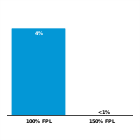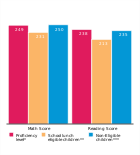State Choices to Promote Access
- Sets the income eligibility limit for child care subsidies at or above 200% FPL [2017]1
A family of three qualifies for assistance at $30,240 or 148% FPL. This reflects a decrease from 149% FPL in 2016. - Child care subsidy reimbursement rate meets the recommended 75th percentile of the market rate [2014]3
- Provides families with at least 12 months of continuous eligibility for child care subsidies [FY 2016]4
- Supplements Early Head Start [2012]5
- Funds a pre-kindergarten program and/or supplements Head Start [FY 2016]6
No Program - Requires districts to offer full day kindergarten [2018]7
State Choices to Promote Quality
- Requires one adult for every four 18-month-olds, and a maximum class size of eight in child care centers [2013]8
Child care regulations require one adult for every 4 children, and there is no maximum class size. - Allocates state or federal funds for a network of infant/toddler specialists that provide assistance to child care providers [2013]9
- Has early learning standards or developmental guidelines for infants and toddlers [2017]10
- Has an infant/toddler credential or certificate [2018]11
- Requires that infants and toddlers in child care centers be assigned a consistent primary caregiver [2016]12
- Requires one adult for every ten 4-year-olds, and a maximum class size of 20 in child care centers [2013]8
Child care regulations require one adult for every 10 children, and there is no maximum class size. - Has implemented a statewide Quality Rating Improvement System (QRIS) [2017]13
- Requires one teacher for every 18 students in kindergarten classrooms [2013]14
Requires one teacher for every 20 students. - Has adopted Common Core Standards [2015]15
NCCP believes that Common Core State Standards should be used in conjunction with guidelines for social emotional learning. - Has comprehensive, free-standing standards for social emotional learning at the K-12 level [2018]16
Data Notes and Sources
Last Updated: May 13, 2015
Send us recent developments to update your state's profile.
- Schulman, K., & Blank, H. (2017). Persistent Gaps: State Child Care Assistance Policies 2017. National Women's Law Center. https://nwlc.org (accessed November 2, 2017). Parents at 150% FPL ineligible for monthly child care copayments in Maryland.
- U.S. Department of Education, Institute of Education Sciences, National Center for Education Statistics. (2018). National Assessment of Educational Progress (NAEP), 2017 Math and Reading Assessment. https://nces.ed.gov (accessed June 29, 2018).
- Schulman, Karen; Blank, Helen. 2014. Turning the Corner: State Child Care Assistance Policies 2014. National Women's Law Center. http://www.nwlc.org (accessed March 3, 2015).
- Minton, S., Blatt, L., Tran, V., Stevens, K., & Giannarelli, L. (2017). The CCDF Policies Database Book of Tables: Key Cross-State Variations in CCDF Policies as of October 1, 2016. OPRE Report 2017-105. Washington, DC: Office of Planning, Research and Evaluation, Administration for Children and Families, U.S. Department of Health and Human Services. https://www.acf.hhs.gov (accessed February 22, 2018).
- Colvard, Jamie; Schmit, Stephanie, Zero to Three and CLASP. 2012. Expanding Access to Early Head Start: State Initiatives for Infants and Toddlers at Risk. http://www.clasp.org (accessed August 15, 2013).
- Barnett, W. S., Friedman-Krauss, A. H., Weisenfeld, G. G., Horowitz, M., Kasmin, R., & Squires, J. H. (2017). The State of Preschool 2016: State Preschool Yearbook. New Brunswick, NJ: National Institute for Early Education Research. http://nieer.org (accessed December 19, 2017).
- Diffey, L. (2018). 50-State Comparison: State Kindergarten-Through-Third-Grade Policies. Denver, CO: Education Commission of the States. http://ecs.force.com (accessed June 29, 2018).
- National Association of Child Care Resource and Referral Agencies. 2013.We Can Do Better: Child Care Aware of America's Ranking of State Child Care Center Regulations and Oversight. http://www.naccrra.org (accessed August 14, 2013).
- Schmit, Stephanie; Matthews, Hannah, CLASP. 2013. Better for Babies: A Study of State Infant and Toddler Child Care Policies. http://www.clasp.org (accessed April 2, 2014).
- Administration for Children & Families, National Center on Early Childhood Quality Assurance. (2017). State Early Learning and Developmental Guidelines. https://childcareta.acf.hhs.gov (accessed December 19, 2017).
- Administration for Children & Families, National Center on Early Childhood Development, Teaching, and Learning. (2018). State/Territory Infant/Toddler Credential Overview, February 2018. Obtained data from staff at ZERO TO THREE.
- Sosinsky, L., Ruprecht, K., Horm, D., Kriener-Althen, K., Vogel, C., & Halle, T. (2016). Including Relationship-Based Care Practices in Infant-Toddler Care: Implications for Practice and Policy. Brief prepared for the Office of Planning, Research and Evaluation, Administration for Children and Families, U.S. Department of Health and Human Services.
- QRIS National Learning Network. (2017). Current Status of QRIS in the States map. http://qrisnetwork.org (accessed February 7, 2017).
- Education Commission of the States. 2013. Early Learning: Kindergarten Online Database. http://ecs.force.com (accessed April 7, 2014).
- Achieve. 2015. Closing the Expectations Gap: 2013 Annual Report on the Alignment of State K-12 Policies and Practice with the Demands of College and Careers. http://www.achieve.org (accessed March 24 2015).
- The Collaborative for Academic, Social, and Emotional Learning (CASEL). (2018). K-12 Learning Goals for SEL in all 50 States. Chicago, IL: CASEL. https://casel.org (accessed June 29, 2018). Data for DC were based on DC Educational Standards.





